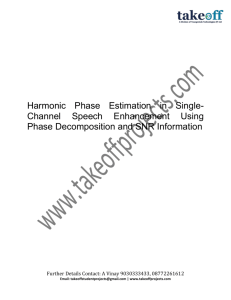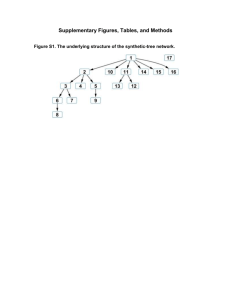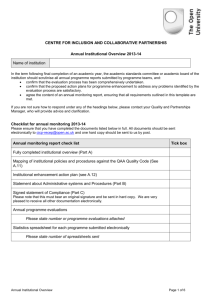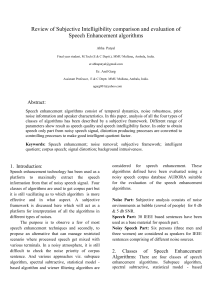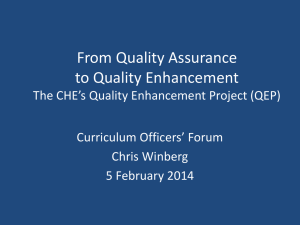- Krest Technology
advertisement
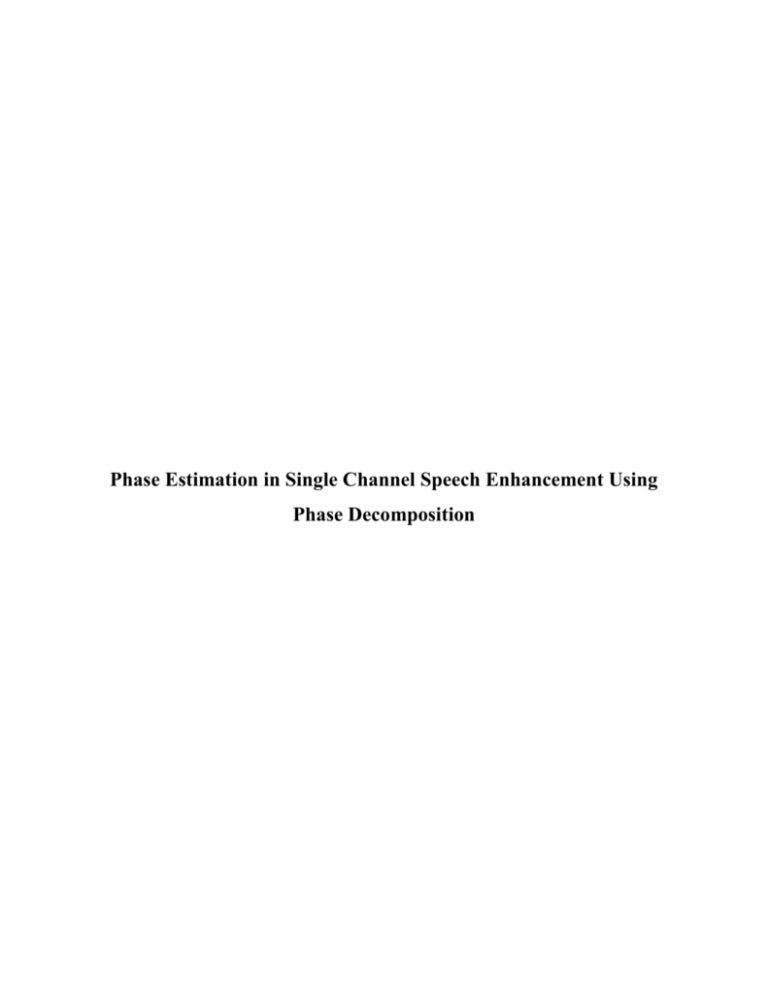
Phase Estimation in Single Channel Speech Enhancement Using Phase Decomposition Abstract Conventional speech enhancement methods typically utilize the noisy phase spectrum for signal reconstruction. This letter presents a novel method to estimate the clean speech phase spectrum, given the noisy speech observation in single-channel speech enhancement. The proposed method relies on the phase decomposition of the instantaneous noisy phase spectrum followed by temporal smoothing in order to reduce the large variance of noisy phase, and consequently reconstructs an enhanced instantaneous phase spectrum for signal reconstruction. The effectiveness of the proposed method is evaluated in two ways: phase enhancement- only and by quantifying the additional improvement on top of the conventional amplitude enhancement scheme where noisy phase is often used in signal reconstruction. The instrumental metrics predict a consistent improvement in perceived speech quality and speech intelligibility when the noisy phase is enhanced using the proposed phase estimation method Index Terms —Phase decomposition, phase estimation, speech enhancement, speech quality, temporal smoothing. 1. INTRODUCTION IN MANY speech applications a speech enhancement pre-processor is required to increase the robustness of the overall system against background noise. To this end, previous methods mainly focus on deriving estimators of the clean speech spectral amplitude given the noisy speech while the noisy phase has been typically directly employed for reconstruction of the enhanced signal. The lower branch in Fig. 1 shows the block diagram for the conventional speech enhancement composed of an amplitude modification stage followed by a synthesis stage where the noisy phase spectrum is typically used unchanged to reconstruct the enhanced signal. Many different noise-suppression rules have been proposed to filter the noisy spectral amplitude. The suppression rules are functions of a priori and a posteriori SNRs estimated from spectral amplitude and noise power spectral density. These methods are either data-driven where training data is exploited as prior knowledge (environment, or user optimized), or are based on a more general prior knowledge related to probability density functions . 2. OBJECTIVE Instrumental metrics were used to predict phase enhancement performance showing 0.2 improvement in PESQ for perceived quality and 2% points improvement in STOI for intelligibility averaged in SNRs, compared to the conventional enhancement using noisy phase in signal reconstruction. 3. PROBLEM DEFINITION We define as the noisy speech signal, where and refer to the th sample of clean speech and the additive background noise, respectively. As the complex values of the STFT, we use uppercase symbols, for example where , and refer to the complex spectrum for noisy speech, clean speech and the interfering noise signal, respectively, with and as the frame index and frequency bin index and as the DFT size. 4. PROPOSED SCHEME When the signal is corrupted in noise, the unwrapped phase component becomes noisy. This motivates us to propose a phase estimation method where we subtract an estimated linear phase from the noisy instantaneous phase and further apply a temporal smoothing filter on the residual unwrapped phase. The temporal smoothing of unwrapped components is motivated by the recent observation in [26] that the glottal source shape (captured by phase dispersion) is known to exhibit smooth changes across time. Furthermore, the authors in proposed phase error filtering (PEF) relying on the minimization of the noisy phase error variance leading to improved speech intelligibility in cochlear implant. Finally, we add back the estimated linear phase to the temporally smoothed unwrapped phase to reconstruct an enhanced instantaneous phase for signal reconstruction. 5. SOFTWARE AND HARDWARE REQUIREMENTS Operating system : Windows XP/7. Coding Language : MATLAB Tool MATLAB R 2012 : SYSTEM REQUIREMENTS: HARDWARE REQUIREMENTS: System : Pentium IV 2.4 GHz. Hard Disk : 40 GB. Floppy Drive : 1.44 Mb. Monitor : 15 VGA Colour. Mouse : Logitech. Ram : 512 Mb. 6. CONCLUSION We presented a new phase enhancement algorithm relying on decomposition of the noisy instantaneous phase and temporal smoothing of the unwrapped phase after removing linear phase. The effectiveness of the proposed method was evaluated in terms of several phase representations showing the harmonic structure in enhanced phase versus the destroyed structure in noisy phase. REFERENCES [1] R. C. Hendriks, T. Gerkmann, and J. Jensen, “DFT-Domain Based SingleMicrophone Noise Reduction for Speech Enhancement,” in Synthesis Lectures on Speech and Audio Processing. San Rafael, CA, USA: . Morgan & Claypool, 2013. [2] S. Srinivasan, J. Samuelsson, and W. B. Kleijn, “Codebook-based Bayesian speech enhancement for nonstationary environments,” IEEE Trans. Audio, Speech, Lang. Process., vol. 15, no. 2, pp. 441–452, Feb. 2007. [3] T. Rosenkranz and H. Puder, “Integrating recursive minimum tracking and codebook-based noise estimation for improved reduction of nonstationary noise,” Signal Process., vol. 92, no. 3, pp. 767–779, 2012. [4] N. Mohammadiha, P. Smaragdis, and A. Leijon, “Supervised and unsupervised speech enhancement using nonnegative matrix factorization,” IEEE Trans. Audio, Speech, Lang. Process., vol. 21, no. 10, pp. 2140–2151, Oct. 2013. [5] C. Breithaupt, T. Gerkmann, and R. Martin, “Cepstral smoothing of spectral filter gains for speech enhancement without musical noise,” IEEE Signal Process. Lett., vol. 14, no. 12, pp. 1036–1039, Dec. 2007. [6] C. Breithaupt, M. Krawczyk, and R. Martin, “Parameterized MMSE spectral magnitude estimation for the enhancement of noisy speech,” in Proc. ICASSP, Mar. 2008, pp. 4037–4040. [7] J. S. Erkelens, R. C. Hendriks, R. Heusdens, and J. Jensen, “Minimum meansquare error estimation of discrete Fourier coefficients with generalized Gamma priors,” IEEE Trans. Audio, Speech, Lang. Process., vol. 15, no. 6, pp. 1741–1752, Aug. 2007. [8] P. Mowlaee, R. Saeidi, and Y. Stylianou, “Phase importance in speech processing applications,” in Proc. 15th Int. Conf. Spoken Language Processing, 2014, pp. 1623–1627.
